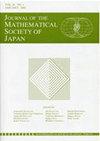超虚上的自同构群
IF 0.7
4区 数学
Q2 MATHEMATICS
引用次数: 0
摘要
本文研究了超虚数e上的拉斯卡群。我们验证了当用e代替实集合上的群时,关于群的各种结果仍然成立。首先,在现有文献中没有书面证明e上的群是拓扑群。我们提出了一个说明性的事实证明,它甚至简化了现有的证明。我们进一步推广了Lascar群的闭子群下轨道等价关系是类型可定义的结果。一方面,我们纠正了第一作者的书中出现的错误,并提出了一个反例。另一方面,我们将“集上的g紧化理论在拉斯卡距离上有一致界”的Newelski定理推广到超虚环境中。最后,我们给出了一个关于相对论拉斯卡群间正则投影核的部分正答案,这在实际中甚至是一个新的结果。一阶完备理论的Lascar(自同构)群及其商群,如Kim-Pillay群和Shelah群,一直是当代模型理论的中心主题。对这些群的研究使我们能够在诸如Lascar型、Kim-Pillay型和Shelah强型等怪物模型上建立群之间的伽罗瓦理论对应关系和它们的轨道等价关系。拉斯卡群及其拓扑的概念是由D.拉斯卡在b[9]中利用超积首次提出的。后来在[7]和[11]中提出了更有利的等效定义,这被认为是现在的标准方法。然而,即使是用拉斯卡群是拓扑群这一基本事实的方法来完整地证明,也不是很容易得到。例如在[2]中,它的证明留给了读者,而证明一点也不琐碎。据我们所知,只有[14]中写了详细的证明。上述结果是关于Lascar群在∅上,或者更一般地说,是关于实集合a上的Lascar群。在本文中,我们研究了超虚e上的Lascar群,并验证了Lascar群在a上的结果如何可以推广到集合被e替换的情况。确实,这种尝试在[8]中做过(并在[6,§5.1]中重写)。然而,这些方法存在一些错误,而且没有证明e上的Lascar群是拓扑群。在本文中,我们以详细的说明性方式提供了事实的证明。我们的证明更直接,甚至简化了群在[14]中的∅。我们也纠正了[6],[8]中提到的错误。特别地,我们修正了e上Lascar群的闭正规子群下轨道等价关系在e上是类型可定义的证明,并将[12]中的Newelski定理推广到超虚环境。也就是说,我们证明,如果T是g紧于e,那么就有2020数学主题分类。主要03 c60;二次54 h11。本文章由计算机程序翻译,如有差异,请以英文原文为准。
Automorphism groups over a hyperimaginary
In this paper we study the Lascar group over a hyperimaginary e. We verify that various results about the group over a real set still hold when the set is replaced by e. First of all, there is no written proof in the available literature that the group over e is a topological group. We present an expository style proof of the fact, which even simplifies existing proofs for the real case. We further extend a result that the orbit equivalence relation under a closed subgroup of the Lascar group is type-definable. On the one hand, we correct errors appeared in the book written by the first author and produce a counterexample. On the other, we extend Newelski’s Theorem that ‘a G-compact theory over a set has a uniform bound for the Lascar distances’ to the hyperimaginary context. Lastly, we supply a partial positive answer to a question about the kernel of a canonical projection between relativized Lascar groups, which is even a new result in the real context. The Lascar (automorphism) group of a first-order complete theory and its quotient groups such as the Kim-Pillay group and the Shelah group have been central themes in contemporary model theory. The study on those groups enables us to develop Galois theoretic correspondence between the groups and their orbit-equivalence relations on a monster model such as Lascar types, Kim-Pillay types, and Shelah strong types. The notions of the Lascar group and its topology are introduced first by D. Lascar in [9] using ultraproducts. Later more favorable equivalent definition is suggested in [7] and [11], which is nowadays considered as a standard approach. However even a complete proof using the approach of the fundamental fact that the Lascar group is a topological group is not so well available. For example in [2], its proof is left to the readers, while the proof is not at all trivial. As far as we can see, only in [14], a detailed proof is written. Aforementioned results are for the Lascar group over ∅, or more generally over a real set A. In this paper we study the Lascar group over a hyperimaginary e and verify how results on the Lascar group over A can be extended to the case when the set is replaced by e. Indeed this attempt was made in [8] (and rewritten in [6, §5.1]). However those contain some errors, and moreover a proof of that the Lascar group over e is a topological group is also missing. In this paper we supply a proof of the fact in a detailed expository manner. Our proof is more direct and even simplifies that for the group over ∅ in [14]. We correct the mentioned errors in [6],[8], as well. In particular we correct the proof of that the orbit equivalence relation under a closed normal subgroup of the Lascar group over e is type-definable over e. Moreover we extend Newelski’s Theorem in [12] to the hyperimaginary context. Namely we show that if T is G-compact over e then there is 2020 Mathematics Subject Classification. Primary 03C60; Secondary 54H11.
求助全文
通过发布文献求助,成功后即可免费获取论文全文。
去求助
来源期刊
CiteScore
1.40
自引率
0.00%
发文量
56
审稿时长
>12 weeks
期刊介绍:
The Journal of the Mathematical Society of Japan (JMSJ) was founded in 1948 and is published quarterly by the Mathematical Society of Japan (MSJ). It covers a wide range of pure mathematics. To maintain high standards, research articles in the journal are selected by the editorial board with the aid of distinguished international referees. Electronic access to the articles is offered through Project Euclid and J-STAGE. We provide free access to back issues three years after publication (available also at Online Index).

 求助内容:
求助内容: 应助结果提醒方式:
应助结果提醒方式:


